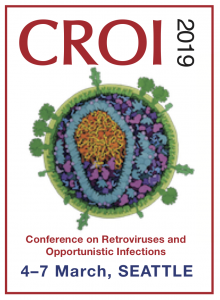Dolutegravir suppresses viral load faster than efavirenz in late pregnancy: results from DolPHIN-2
12 March 2019. Related: Conference reports, Pregnancy, CROI 26 (Retrovirus) 2019.
 Polly Clayden, HIV i-Base
Polly Clayden, HIV i-Base
Women living with HIV starting dolutegravir (DTG)-based ART after presenting in late pregnancy achieved more rapid virological suppression before delivery than those who started with an efavirenz (EFV)-based regimen – according to findings from the DolPHIN-2 study, shown at CROI 2019.
But, late presentation in pregnancy is associated with poor outcomes despite ART and regardless of ART regimen.
DolPHIN-2 (NCT03249181) is an open label study, randomising pregnant women from Uganda and South Africa starting ART from 28 weeks’ gestation to DTG vs EFV plus 2NRTIs.
The primary endpoint is viral load <50 copies/mL at delivery (up to 14 days postpartum) for efficacy, and drug-related adverse events in mothers and infants.
Professor Saye Khoo from the University of Liverpool presented data on behalf of the study group.
All 268 randomised mothers were included in the safety and 237 (122 DTG, 115 EFV) in the efficacy analyses. Data were censored 31 January 2019.
Baseline characteristics were similar between arms: median maternal age was 28 years; viral load 4.5 log10 copies/mL, CD4 count 446 cells/mm3 and gestation 31 weeks.
Viral load was measured at baseline, 1 week and 4 weeks after starting ART, then at 36 weeks’ gestation and delivery, and 6 weeks postpartum.
Median time on ART at delivery was 55 days (IQR 33–77): DTG 52 days (IQR 30–74) vs EFV 59 (IQR 38–82).
By ITT analysis, viral load <50 copies/mL at delivery was significantly higher with DTG (90/122, 73.8%) vs EFV (49/115, 42.6%): RR 1.66 (95% CI 1.32 to 2.08), p<0.0001. Viral load <1000 copies/mL was also higher with DTG (113/122, 92.6%) vs EFV (95/115, 82.6%): RR 1.11 (95% CI 1.00 to 1.23), p=0.05.
There were three vertical transmissions – all in the DTG arm. Mothers had received 35, 32 and 24 days of ART pre-delivery, which they started at respectively 32, 32 and 30 weeks’ gestation. Their respective infants had 4, 3 and 2 positive PCRs with the first at 5, 3 and 11 days after delivery. Maternal viral load at delivery was 29, 20 and 200 copies/mL for the respective cases. All four were judged likely to be in-utero transmissions.
DTG was well-tolerated in pregnancy with no differences with EFV in frequency or organ class of severe adverse events.
There were four stillbirths – all in the DTG arm. These were judged not related or unlikely to be related to ART or maternal IRIS.
Among 242 evaluable live births, median gestation at delivery was 39.9 weeks in both arms with similar rates of preterm and very preterm deliveries: 16% and 5% respectively overall.
About half of the infants had at least one SAE. There were 7 infant deaths (DTG 4 and EFV 3) also judged not related or unlikely to be related to ART or maternal IRIS.
Overall 38% of infants had congenital, familial and genetic anomalies. But excluding congenital umbilical hernia (29.8%) and birthmark (15.3%) these were in the normal range and there were no neural tube defects.
In conclusion, DTG achieves faster virological suppression before delivery compared with EFV and is well tolerated.
The three infant infections were likely to be in-utero transmissions. The four still births in the DTG arm were associated with known risk factors and unlikely to be related to ART.
Polly Clayden is on the trial steering committee of DolPHIN-2.
comment
As previously reported, HIV positive women who start ART in late pregnancy are a vulnerable group with a higher risk of adverse outcomes and vertical transmission of HIV than those who start earlier.
Infant deaths, stillbirths and infant infections seen in DolPHIN-2 corroborate this. Such women are difficult to reach (and to recruit in to studies) but efforts must be made to ensure that they receive care and treatment earlier in pregnancy.
Mothers and infants in DolPHIN-2 will be followed to 72 weeks after delivery.
Reference
Kintu K et al. RCT of dolutegravir vs efavirenz-based therapy initiated in late pregnancy: DolPHIN-2. CROI 2019. Seattle. 4–7 March 2019. Oral abstract 40LB.

